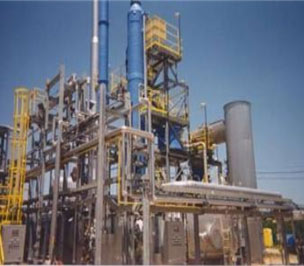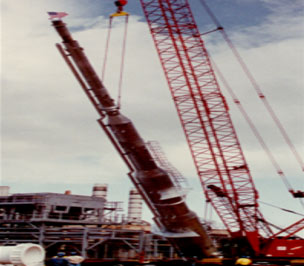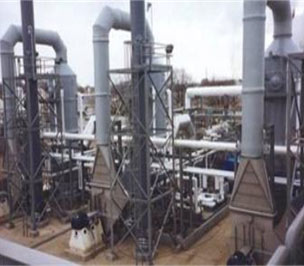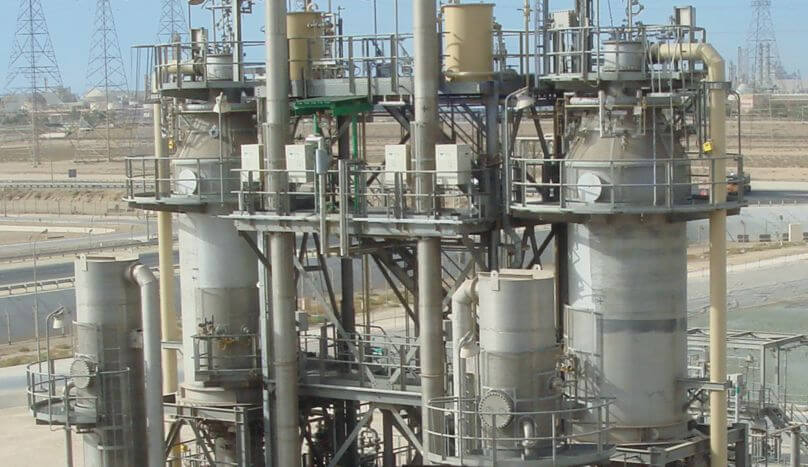Process Thermal Oxidizers
We offer process thermal oxidizers that provide an efficient solution for gas and liquid waste environmental challenges. Process thermal oxidizers, sometimes referred to as emissions abatement devices, are used in a wide array of applications and come in varying configurations.
Our team applies our extensive experience along with leading technologies to develop a custom designed solution to meet or exceed strict environmental regulations, such as NOx, DRE and CO standards.
- Fume
- Liquid
- Tail Gas
- Halogenated Waste
Fume
 Typically fume combustors are installed to combust.
Typically fume combustors are installed to combust.
Typically in these systems the waste stream is comprised of air or nitrogen with small amounts of VOCs or hydrocarbons. The combustors on these systems are often lined with ceramic fiber refractory and are forced draft. They operate between 1400F to 1600F and can have destruction efficiencies from 95% to 99.99%. Heat recovery or steam generation is possible depending on the application.
Usually the gases going to the fume combustor are exothermic.
Typical Equipment
- Low emissions burner
- Ceramic fiber refractory
- Forced draft operation
- Heat recovery equipment
- Burner management system/Safety systems
- Stack
- Combustion control systems
Typical Waste Streams
- VOC streams
- Process vents
- Pharmaceutical vents
- Dryer exhausts
Typical Installation
- 5 to 100 MM BTU/hr burner
- 1 second residence time
- 1500F operating temperature
Liquid
Aqueous or organic waste streams containing inorganic or organic salts require that the thermal oxidizer be down-fired to prevent the accumulation of molten salts. Aqueous waste streams are injected directly into the thermal oxidizer while organic waste may be burnt like a fuel and fired through the burner. Salt or ash laden flue gas from the oxidizer is quenched to its adiabatic saturation temperature by water injection in a quench system located directly below the thermal oxidizer. Saturated flue gas from the quench system goes through a particulate matter removal system before being released to the atmosphere via the stack.
Typical Equipment
- Low emission burner
- Low porosity brick refractory
- Forced draft
- Adiabatic quench
- Particulate removal
- Acid Removal
- Dioxin/Furan abatement equipment
Typical Waste Streams
- Ethylene plant blowdown
- Caustic waste streams
Typical Installation
- Chemical plant
- 5 to 150 MMBTU/hr burner firing range
- 2.0 seconds residence time
- 1650F-1800F operating temperature
Tail Gas
 Tail Gas Thermal Oxidizers – DRE range of 99% to 99.999%, effectively destroying sulfur components found in sulfur recovery unit tail gas. Proper thermal oxidizer technology balances desired H2S destruction efficiencies, NOx formation and minimized CO production to meet environmental regulations. Typical oxidizing temperatures vary from 1200F to 1800F, with residence times of 0.6 to 1.0 second. System designs for both natural or forced draft are available.
Tail Gas Thermal Oxidizers – DRE range of 99% to 99.999%, effectively destroying sulfur components found in sulfur recovery unit tail gas. Proper thermal oxidizer technology balances desired H2S destruction efficiencies, NOx formation and minimized CO production to meet environmental regulations. Typical oxidizing temperatures vary from 1200F to 1800F, with residence times of 0.6 to 1.0 second. System designs for both natural or forced draft are available.
Typical Equipment
- DeNOx Systems
- SOx Removal Systems
- Low emissions burner
- Castable or brick refractory
- Natural draft/ forced draft
- Heat recovery (optional)
- Stack
Typical Waste Streams
- Sulfur plant tail gas
- Carbon black tail gas
Benefits
- Refineries
- Natural Gas Processing Plants
- 20 to 150 MM BTU/hr burner
- 1 second residence time
- 1200F-1500F operating temperature
Halogenated Waste
 These systems can be designed to handle either gas or liquid streams. They are typically forced draft systems with a vertical or horizontal combustor that is lined with high alumina brick refractory. Capable of destruction efficiencies of 99-99.999 percent; operating temperatures can range from 1500F to 2200F with residence times of 1.0 to 2.0 seconds depending on the destruction efficiency required.
These systems can be designed to handle either gas or liquid streams. They are typically forced draft systems with a vertical or horizontal combustor that is lined with high alumina brick refractory. Capable of destruction efficiencies of 99-99.999 percent; operating temperatures can range from 1500F to 2200F with residence times of 1.0 to 2.0 seconds depending on the destruction efficiency required.
Typical Equipment
- Medium intensity burner
- Forced draft
- High alumina brick refractory
- Heat recovery equipment
- HCl recovery/scrubber
Typical Waste Streams
- PVC plant vents
- VCM waste liquids
- Pharmaceutical vents
- Bromine liquid wastes
Typical Installation
- Chemical plant
- 10 to 50 MM BTU/hr burner
- 2.0 seconds residence time
- 1800F operating temperature

